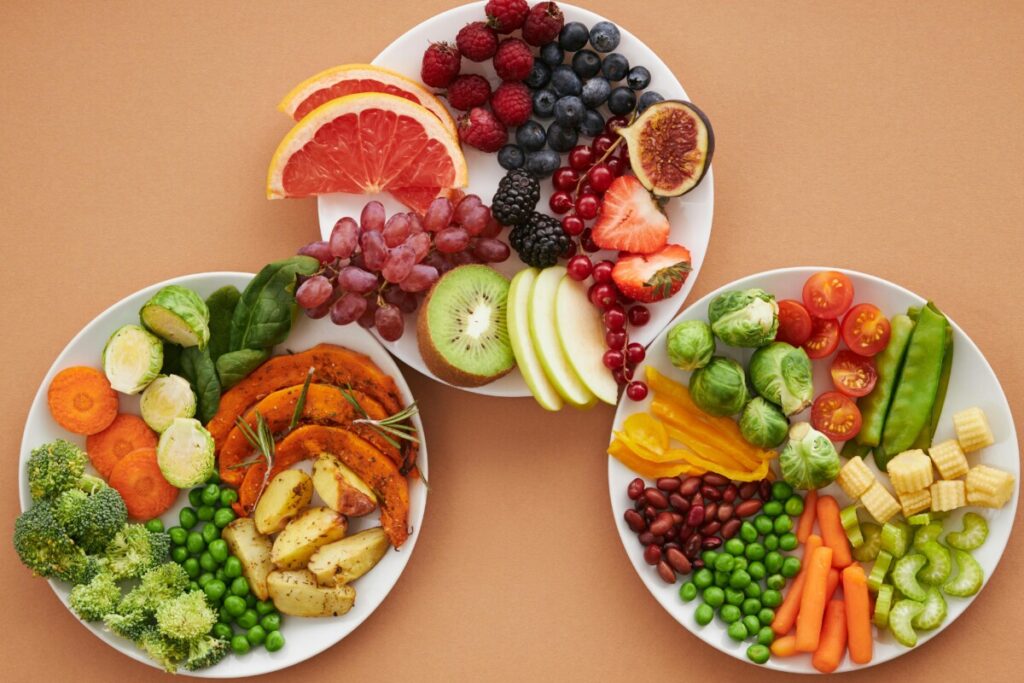The Art of Healthy Eating Demystified

Welcome to our blog post on the art of healthy eating demystified! In today’s fast-paced world, it can be challenging to navigate through endless opinions and information about what constitutes a healthy diet. That’s why we’re here to help unravel the secrets and provide you with insights into achieving balanced nutrition and overall well-being.
Exploring Holistic Eating for Optimal Health
When it comes to nourishing our bodies, it’s not just about the specific nutrients we consume but also the overall approach to our eating habits. Holistic eating focuses on nourishing our bodies, minds, and souls, creating a harmonious connection between what we eat and our overall well-being.
What is Holistic Eating?
Holistic eating is an approach to food that takes into account not just the nutritional content of the food we eat but also the quality of our eating experience. It is about listening to our bodies, being present in the moment, and cultivating a positive relationship with food.
Unlike a strict diet mentality that focuses solely on calorie counting or restricting certain food groups, holistic eating aims to create balance and nourishment on a deeper level. It encourages us to view food as a source of energy, healing, and pleasure.
The Benefits of Holistic Eating
By adopting a holistic eating approach, we can experience various benefits that go beyond physical health:
Mental and Emotional Well-being: Holistic eating emphasizes the connection between body and mind, fostering positive relationships with food that can improve our mental and emotional well-being.
Improved Digestion: A key aspect of holistic eating is mindful eating, which involves being fully present during meals. This can enhance our digestion process, leading to better nutrient absorption and reduced digestive discomfort.
Enhanced Intuitive Eating: Holistic eating encourages us to listen to our bodies’ signals of hunger and fullness. By tuning in to our internal cues, we can better regulate our food intake and avoid overeating or restrictive behaviors.
Boosted Energy Levels: When we provide our bodies with nutrient-dense, whole foods, we can experience improved energy levels throughout the day, helping us perform at our best in various activities.
Overall, holistic eating promotes a balanced and sustainable approach to nutrition, taking into account both physical and emotional nourishment.
Nourishing Your Body with Nutrient-Rich Meals
One of the keys to maintaining optimal health is nourishing your body with nutrient-rich meals. These meals are packed with essential vitamins, minerals, and other nutrients that support your overall well-being. Here are some benefits of incorporating nutrient-rich ingredients into your meals:
1. Enhanced Energy Levels
By fueling your body with nutrient-dense foods, you can experience increased energy levels throughout the day. Nutrients like complex carbohydrates, healthy fats, and lean proteins provide a steady release of energy, keeping you energized and focused.
2. Stronger Immune System
A diet rich in nutrients helps boost your immune system, making you more resilient to illnesses and infections. Vitamins A, C, and E, as well as minerals like zinc and selenium, play a vital role in supporting immune function.
3. Improved Digestion
Nutrient-rich meals often contain a good amount of dietary fiber, which aids in proper digestion. Fiber helps regulate bowel movements, prevents constipation, and supports a healthy gut microbiome.
4. Healthier Skin, Hair, and Nails
Many nutrients contribute to healthier skin, hair, and nails. For example, omega-3 fatty acids found in fatty fish help nourish the skin, while biotin and other B vitamins support hair and nail health.
Maximizing the Nutritional Value of Your Dishes
Incorporating nutrient-rich ingredients into your meals is only half the battle.
To maximize the nutritional value of your dishes, consider the following tips:
Choose fresh and locally sourced ingredients whenever possible.
Opt for cooking methods that preserve the nutrients in the food, such as steaming or baking, instead of deep-frying.
Pair foods that enhance nutrient absorption, such as vitamin C-rich foods with iron-rich foods.
Avoid overcooking vegetables to retain their valuable nutrients.
Experiment with different herbs and spices to add flavor without relying on excessive salt or unhealthy ingredients.
Include a variety of colors on your plate, as different colors often indicate different types of nutrients.
By following these tips, you can ensure that your meals are not only delicious but also packed with the essential nutrients your body needs to thrive.
https://serenity7wellness.com/index.php/2023/11/22/mediterranean-baked-tilapia-with-herbs-and-lemon/
Achieving Dietary Wellness
Maintaining a healthy and balanced diet is essential for overall wellness. By ensuring you have a well-rounded eating plan, you can provide your body with the necessary nutrients it needs to thrive.
Here are some key components to consider when aiming for dietary wellness:
1. Understanding the Key Components of a Healthy and Balanced Diet
A healthy and balanced diet is a combination of different food groups that provide a range of essential nutrients.
These include:
Proteins: Found in lean meats, poultry, fish, eggs, legumes, and nuts.
Carbohydrates: Obtained from whole grains, fruits, vegetables, and dairy products.
Fats: Essential fats can be sourced from avocados, nuts, seeds, and healthy oils.
Vitamins and Minerals: Found in a variety of fruits, vegetables, and supplements, these nutrients play crucial roles in maintaining overall health.
Water: Staying hydrated is important for digestion, nutrient absorption, and overall bodily functions.
2. Tips for Creating a Sustainable and Nourishing Eating Plan
Creating a sustainable and nourishing eating plan involves:
Meal Planning: Plan your meals ahead of time to ensure they include a balance of nutrients and can be prepared with ease.
Diversify Your Food Choices: Experiment with different fruits, vegetables, whole grains, and lean proteins to keep your meals interesting and packed with various nutrients.
Moderation: Practice portion control and moderation to avoid overeating or under-eating certain food groups.
Listen to Your Body: Pay attention to your body’s hunger and fullness cues to ensure you’re eating when you’re hungry and stopping when you’re satisfied.
Seek Professional Guidance: If necessary, consult a registered dietitian or nutritionist for personalized advice and assistance in creating a dietary plan that suits your specific needs.
By following these guidelines, you can achieve dietary wellness and support your overall health and well-being.
Culinary Health Insights: Enhancing Your Well-Being Through Food
When it comes to our well-being, food plays a crucial role. The choices we make in the kitchen can have a profound impact on our overall health. But it’s not just about the ingredients we use, it’s also about how we cook and prepare our meals.
The impact of different cooking methods on the nutritional value of food
Did you know that the way you cook your food can affect its nutritional content? Certain cooking methods can enhance the availability of nutrients, while others can cause nutrient loss. For example, steaming retains more nutrients compared to boiling, and roasting can enhance flavor and texture while maintaining essential vitamins and minerals. By understanding the impact of various cooking techniques, you can make informed choices that help preserve the nutritional value of your meals.
Exploring the connection between food and overall well-being
Food is not just fuel for our bodies; it has a profound impact on our overall well-being. Research shows that certain foods can reduce the risk of chronic diseases, improve cognitive function, and even enhance mood and energy levels. By incorporating nutrient-dense ingredients into your diet, you can optimize your body’s functions and support your overall well-being. For example, including omega-3 fatty acids from foods like salmon, walnuts, and flaxseeds can promote heart health and reduce inflammation.
Tip: When planning your meals, consider the health benefits of different ingredients and aim to create a balance of nutrients to support your well-being.
By exploring the connection between food and overall well-being, you can make informed choices that nourish your body and support your long-term health goals.
Unleashing the Power of Nutritious Recipes
When it comes to eating healthy, finding delicious recipes that are also nutritious can sometimes feel like a challenge. However, with a little creativity and knowledge, you can unlock the power of nutritious recipes that nourish your body and satisfy your taste buds.
Here are some tips to help you on your culinary journey:
Finding Nutritious Recipes
1. Explore Healthy Recipe Blogs and Websites: There are plenty of blogs and websites dedicated to sharing nutritious recipes. Look for ones that focus on using whole, unprocessed ingredients and offer a variety of options for different dietary preferences.
2. Utilize Social Media: Follow health-conscious influencers and chefs on platforms like Instagram and Pinterest. They often share mouthwatering recipes that are both nutritious and visually appealing.
3. Join Healthy Cooking Communities: Online communities and forums dedicated to healthy cooking can be a great resource for discovering new recipes. Connect with like-minded individuals who share their favorite nutritious dishes.
Creating Nutritious Recipes
1. Incorporate Colorful Vegetables and Fruits: Vary your recipes by including a wide range of colorful vegetables and fruits. These are packed with essential vitamins, minerals, and antioxidants that promote overall health.
2. Opt for Lean Proteins: Choose lean sources of protein such as skinless poultry, fish, legumes, and tofu. These provide essential amino acids necessary for building and repairing body tissues.
3. Experiment with Whole Grains: Replace refined grains with whole grains like quinoa, brown rice, and whole wheat pasta. Whole grains offer more fiber, vitamins, and minerals than their refined counterparts.
4. Reduce Added Sugars: Minimize your use of added sugars and opt for natural sweeteners like honey or maple syrup. This helps to lower the overall sugar content of your recipes.
5. Use Healthy Cooking Methods: Opt for baking, grilling, steaming, or sautéing instead of deep-frying. These methods preserve the nutrients in the ingredients while minimizing the use of unhealthy fats.
6. Experiment with Herbs and Spices: Enhance the flavor of your recipes without adding excess salt or unhealthy seasonings by using a variety of herbs and spices.
7. Stay Hydrated: Remember to include plenty of hydrating ingredients such as fruits, vegetables, and water in your recipes to help maintain proper hydration.
By following these tips and being open to new flavors and ingredients, you can unleash the power of nutritious recipes and enjoy delicious meals that support your overall health.
Mastering the Art of Mindful Eating
Practicing mindful eating is a powerful tool to enhance both the enjoyment and nutritional benefits of your meals. By being present and fully engaged with your food, you can develop a deeper connection with your body and its needs.
Here are some techniques to incorporate mindfulness into your daily meals:
Savor each bite: Take the time to truly taste and appreciate the flavors, textures, and aromas of your food. Slow down and chew your food thoroughly, allowing yourself to fully experience each bite.
Eat without distractions: Avoid eating in front of the TV or while scrolling on your phone. Instead, create a calm and quiet atmosphere where you can focus solely on the act of eating.
Listen to your body: Pay attention to your body’s hunger and fullness cues. Eat when you are truly hungry and stop eating when you are comfortably satisfied, rather than eating until you are overly full.
Practice gratitude: Before starting your meal, take a moment to express gratitude for the nourishment in front of you. This can help cultivate a positive and appreciative mindset towards your food.
Avoid judgment: Let go of any guilt or judgment associated with certain foods. Instead, focus on the nourishment and pleasure that food provides, without attaching any negative emotions.
Engage your senses: Notice the colors, smells, and textures of your food. Engage all your senses to fully immerse yourself in the experience of eating.
By mastering the art of mindful eating, you can not only improve your digestion and satisfaction with meals but also develop a healthier relationship with food overall.
Conclusion
In conclusion, the art of healthy eating is not as mystifying as it may seem. By understanding the importance of balanced nutrition, nourishing your body with nutrient-rich meals, exploring holistic eating, achieving dietary wellness, and incorporating culinary health insights, you can enhance your overall well-being through the food you consume.
Remember to be mindful of the ingredients you use and the cooking methods you employ to maximize the nutritional value of your meals. Seek out and create nutritious recipes that are also delicious, and make a conscious effort to practice mindful eating in order to fully experience the benefits it has on your health and well-being. By making small, sustainable changes to your eating habits and embracing a holistic approach to food, you can start on a path towards a healthier and more fulfilling life.








